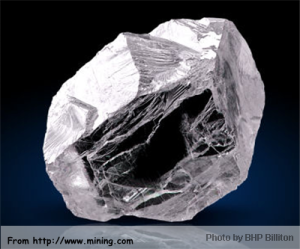A recent paper by Schultze et al. in Geology provides constraints on the origin of carbon and diamonds. The paper argues that eclogite-type diamonds are formed from recycled subducted oceanic crust. The study utilized the carbon and oxygen isotopes of carbonate and coesite (high pressure quartz) inclusions within eclogite-type (E-type) diamonds from Venezuela, Botswana and Western Australia. The research illustrates that unlike mantle materials that have very restricted carbon and oxygen isotope compositions, the carbon and oxygen isotope signatures in the inclusions within diamonds are inconsistent with a mantle origin. In contrast, they have much higher oxygen isotope compositions, typical of ocean crust that underwent low temperature seawater-rock interaction (see Muehlenbachs and Clayton, 1976), and lower carbon isotope signatures indicative of the trapping of biogenic carbon within oceanic crust during oceanic crust weathering processes (see Furnes et al. 2004)(Fig. 1).

Figure 1. Carbon and oxygen isotope plot of carbonate and coesite (quartz) inclusions in diamonds. The data show that a significant number of samples lie in the ocean floor origin-biogenic carbonate (OFO-BIC) field consistent with derivation from recycled oceanic crust. Figure from Schultze et al. (2013).
The general question is how does the ocean crust ultimately end up forming diamonds? The subduction of oceanic crust often leads to the accretion of subducted oceanic crustal slabs to the base of the cratons (e.g., Cook et al., 1999; Helmstaedt et al., 2010; Fig. 2). Over time these slabs with biogenic carbon from the ocean floor mature and under the right pressure and temperature conditions (i.e., the diamond window) form diamonds. The diamonds are often associated with kimberlites, a highly gas-rich magma, the latter acting as a carrier for the diamonds to the Earth’s surface/near-surface (e.g., K1, K2, and K3 in Figure 2).
Figure 2. Cross section of the diamond-bearing Slave Craton, northern Canada. The cross-section shows the older Archean root to the craton (~4-2.9 Ga) underlain by ancient oceanic crustal domains of Proterozoic age (1.92-1.88 Ga). This recycled oceanic crust was likely the source of some of the eclogite-type diamonds (E-type) that came up in the much younger kimberlite (K1, K2, K3) fields. Diagram from Helmstaedt et al. (2010).
The work builds on previous work by Schulze and co-workers, as well as other researchers (e.g., Tappert et al. 2005).


